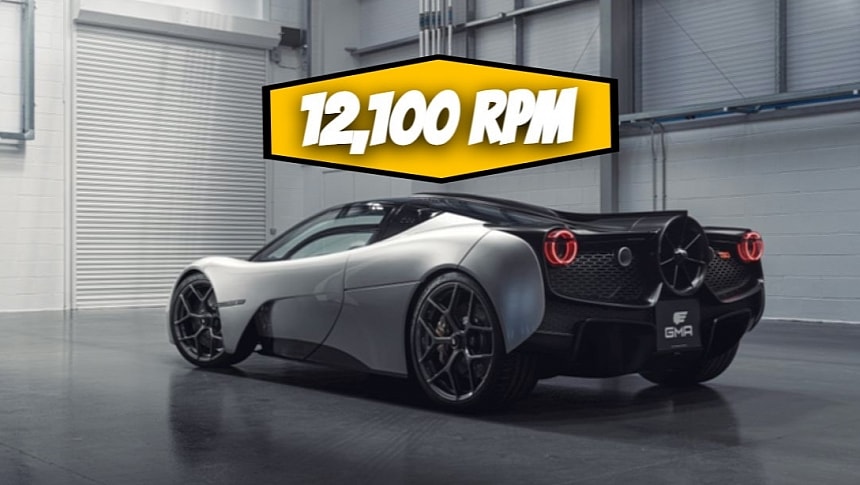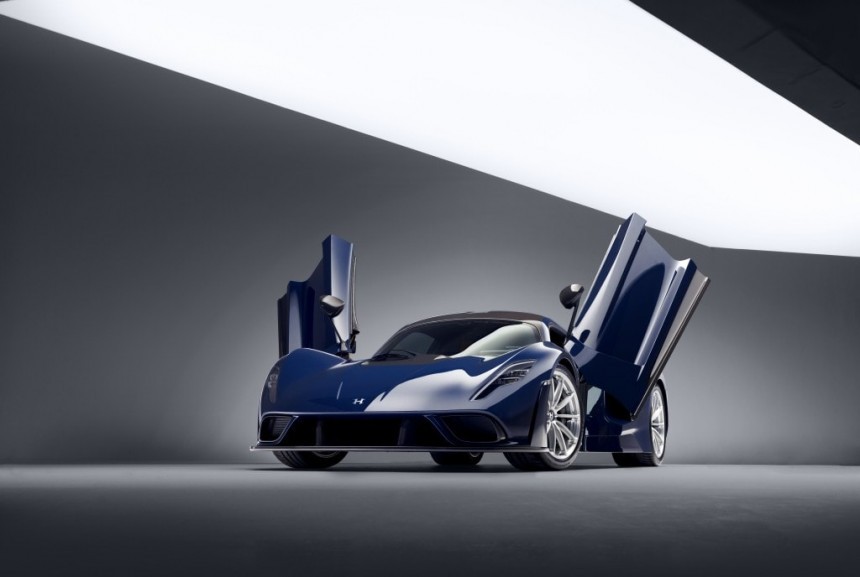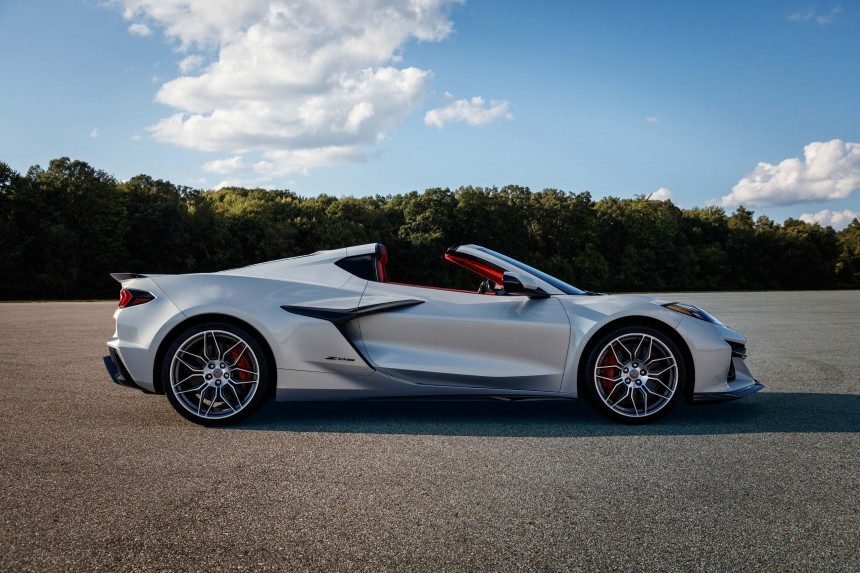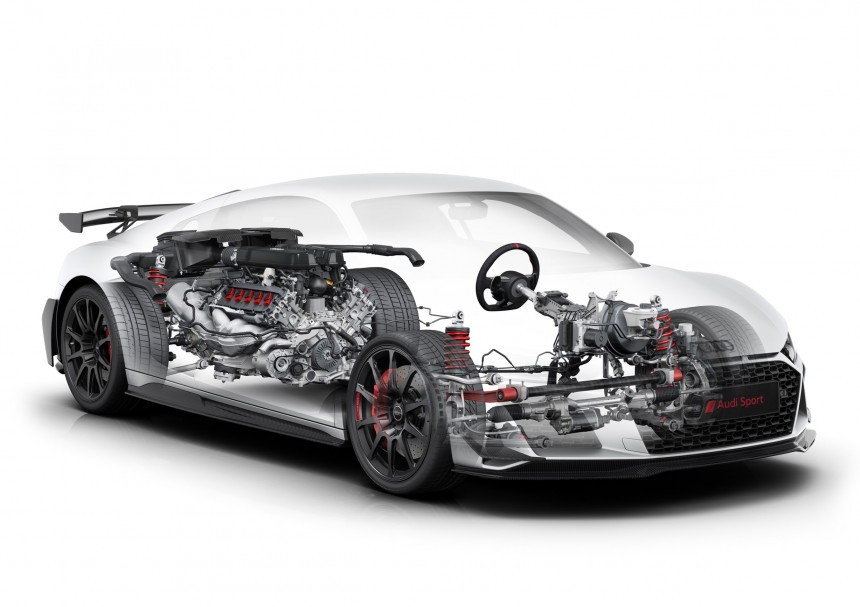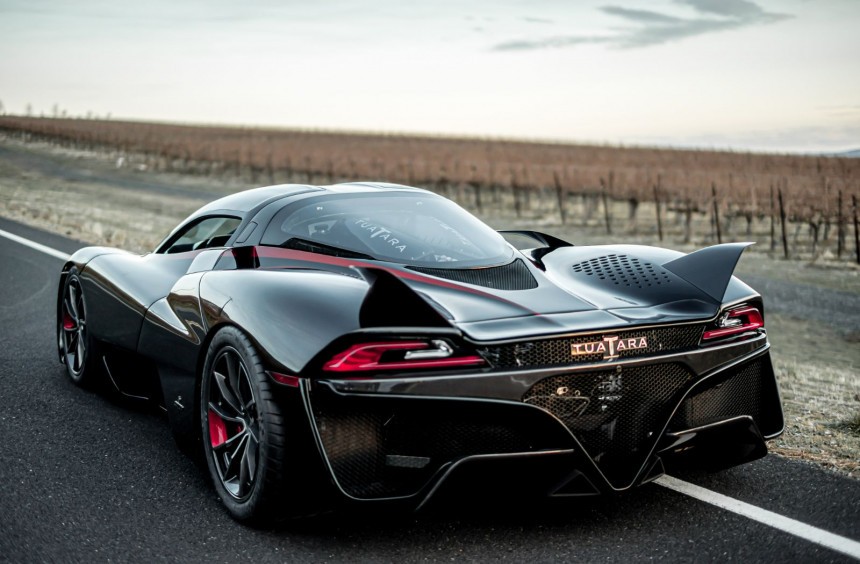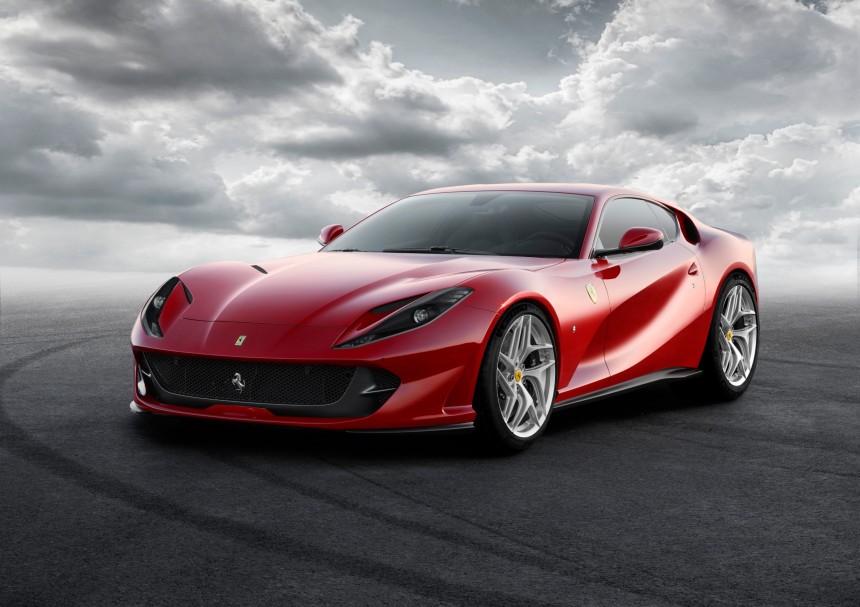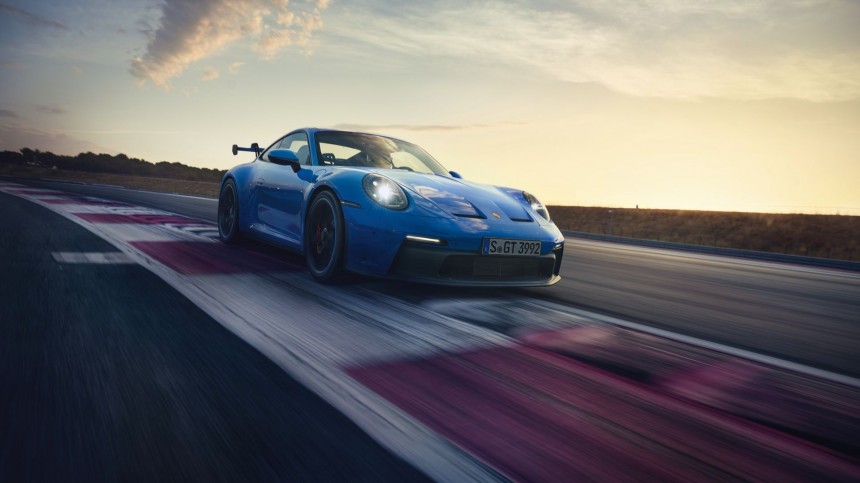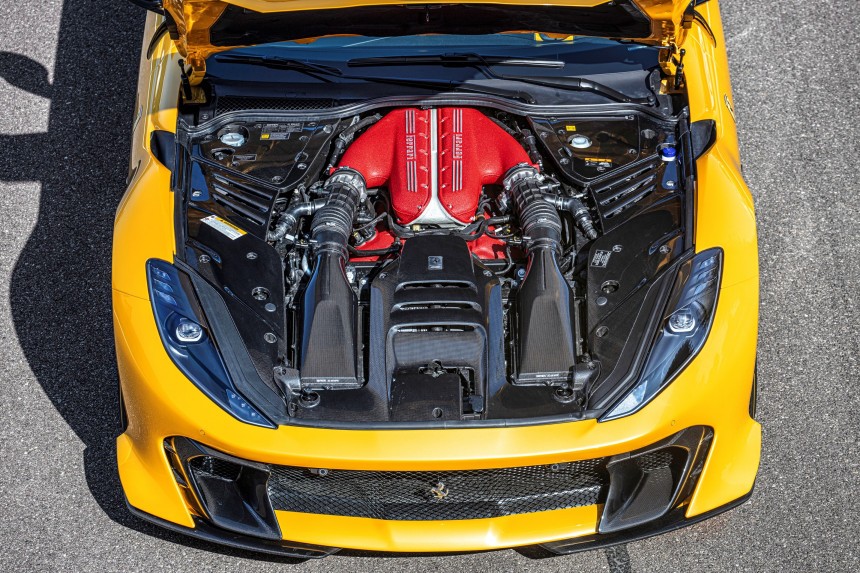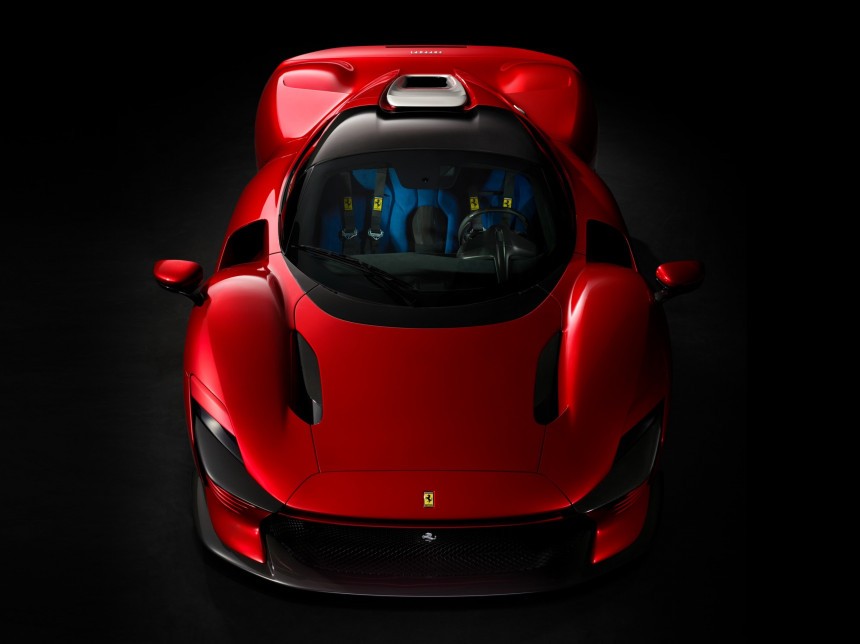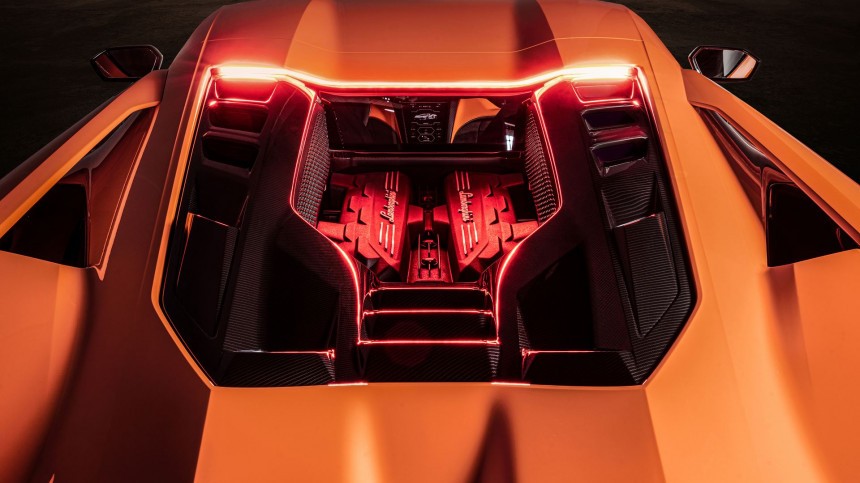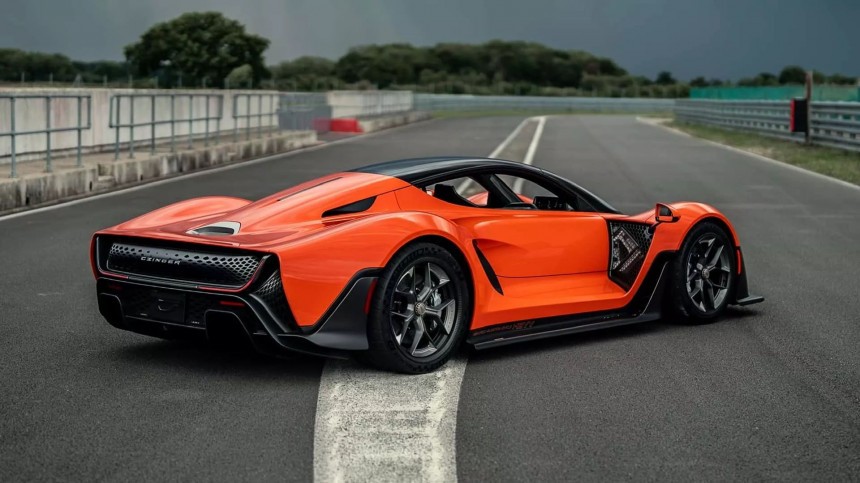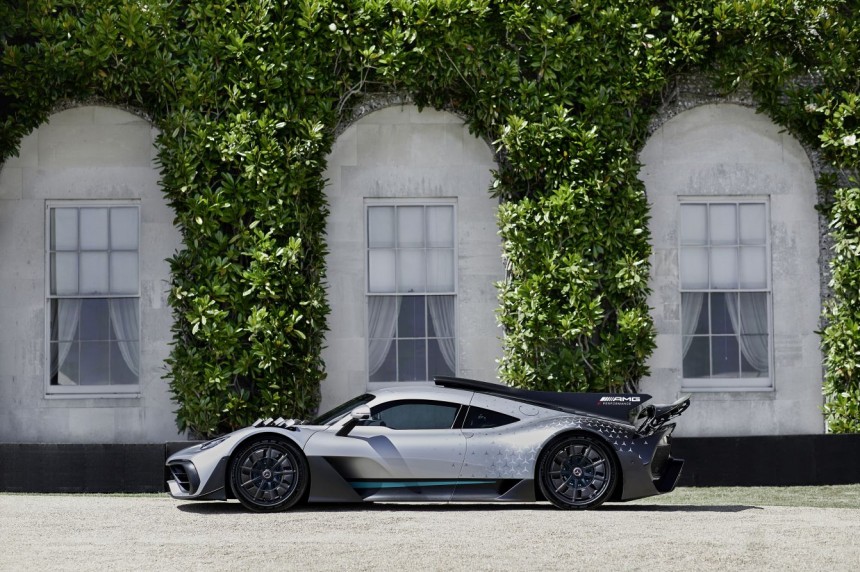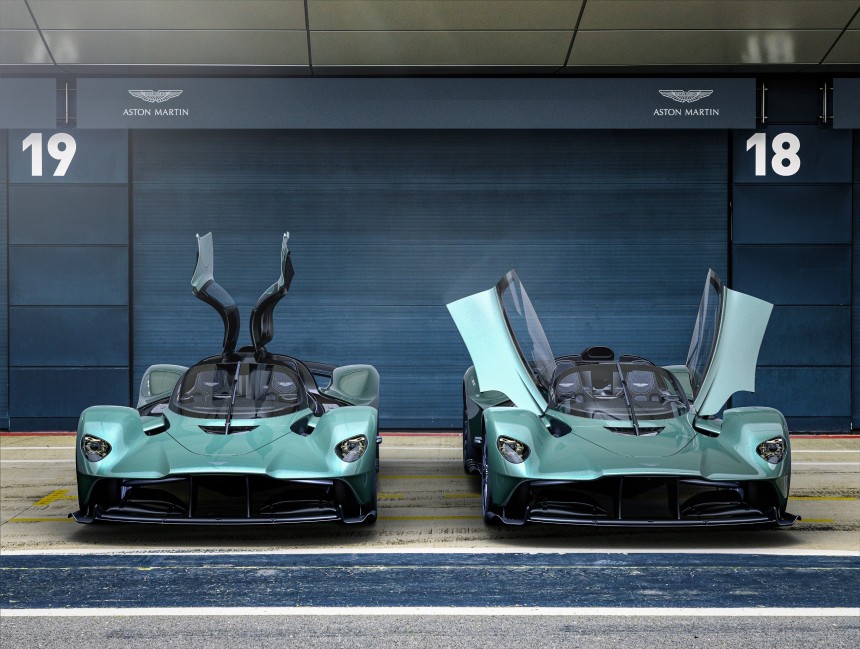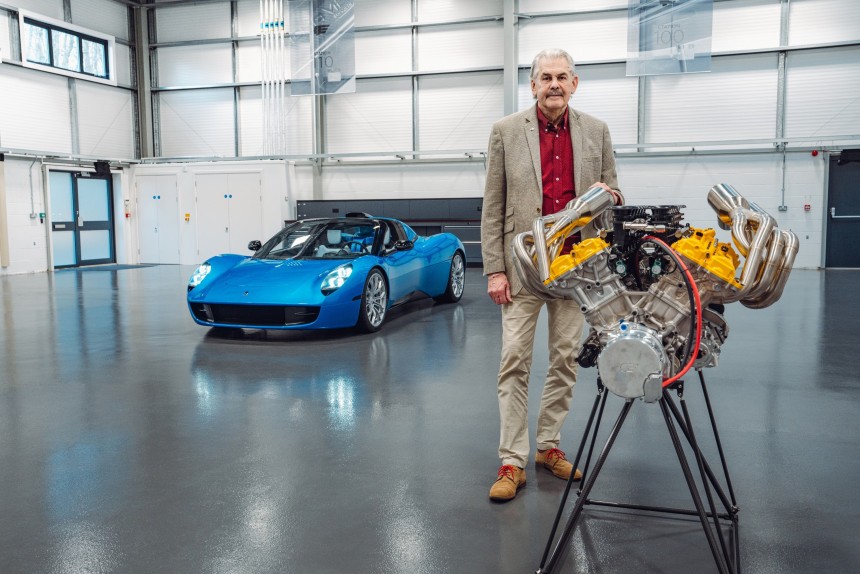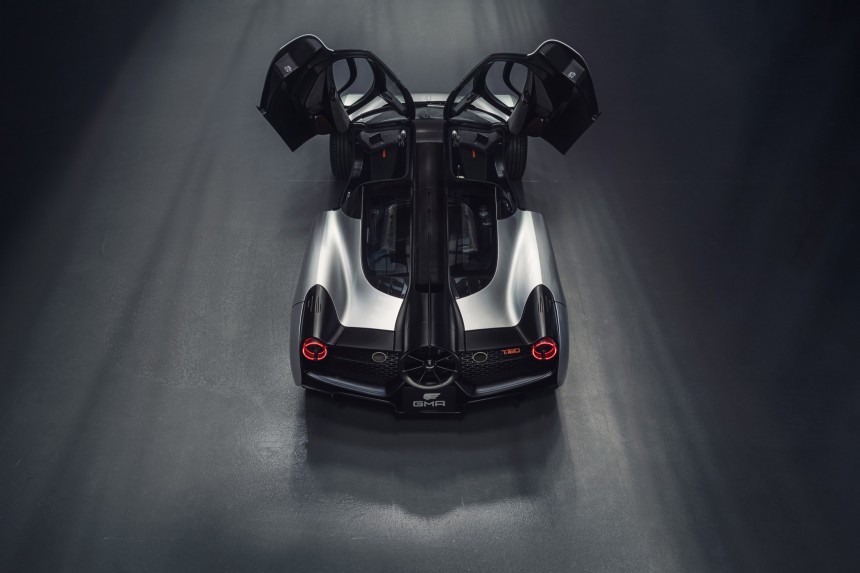Not that long ago, internal combustion engines capable of spinning north of 10,000 revolutions per minute were restricted to hi-po motorcycles and racing cars. The four-pot Honda CBR250RR comes to mind with its 19,000-rpm redline, whereas the McLaren MP4/4 is believed to crank out close to 700 ponies at 12,500 revolutions per minute.
At the moment of writing, only a handful of production cars are obliged to rev past 10,000 rpm without grenading their engines. The big question is, why bother developing such a thing? First and foremost, aural pleasure is a huge selling point in this day and age. But even more importantly, a high-revving engine's big bore and short stroke allow for more space for the valves and – of course – faster valve timing to boot.
The aforementioned setup does have its drawbacks. Power and torque sitting higher up in the rev range is one thing, but such engines gulp on dinosaur juice at an alarming rate. The FPC V8 of the Corvette Z06 is a pretty good example, with the EPA estimating 15 miles per gallon (15.7 liters per 100 kilometers) combined as opposed to 19 (12.4) for the small-block V8 powering the Corvette Stingray.
As a rule of thumb, horsepower is a function of torque times engine speed. Or you can put it this way: more revolutions per minute, more power. That said, let's find out which are the highest-revving cars of 2024.
Taking the lessons learned from the record-breaking Venom GT, the Venom F5 is the most powerful American car that money can buy at press time. Teased in 2014, then revealed in the form of a full-size mockup in 2017, the midship land missile brings together two aluminum alloy cylinder heads and a cast-iron block with the same cylinder bore (4.1 inches) as the LS7 from General Motors.
As opposed to the 7,000-rpm LS427/570 crate engine, which makes 570 horsepower at 6,200 revolutions per minute, the Hennessey Fury belts out a staggering 1,817 horsepower at 8,000 revolutions per minute with 500 rpm to spare. Its ceramic-coated turbos with 76-millimeter compressor wheels enable a turbo diesel pickup truck-shaming 1,193 pound-feet (1,617 Nm).
Clad in carbon fiber, the Venom F5 is limited to 90 units. Originally priced at $1.6 million, the second hypercar to come out of Sealy, Texas had its starting price raised to $2.1 million in December 2020.
Conceived by the guy who convinced General Motors to shoehorn a small block in the engine bay of the C1, the Z06 package rolled out for the 1963 model year in the C2. The latest Z06, however, stands out due to its flat-plane crankshaft V8.
The LT6 designation may be a reference to the LT series of small blocks, yet other than the 4.4-inch bore spacing and 90-degree V angle, it's a completely different animal from the LT2 in the Stingray. Redlining at 8,600 revolutions per minute, the 5.5-liter mill also happens to be the largest flat-plane crankshaft V8 to power a production vehicle, besting the Shelby GT350's 5.2-liter Voodoo.
The Z06 is advertised with 670 horsepower, meaning 121.8 ponies for every liter of displacement. Come 2025, the LT6 will be joined by a twin-turbo version dubbed LT7 in the ZR1.
The four-ringed automaker from Ingolstadt initially announced that R8 production would come to a screeching halt by the end of 2023. For some reason or another, Audi extended the deadline. The final example of the breed should be finished by the end of March 2024, with assembly taking place at the Bollinger Hofe plant in Heilbronn, Germany.
There is a common misconception that the 5.2-liter V10 in the R8 is a Lamborghini engine. In truth, Self-Study Program 376 states that the 5.2 FSI we all know and love "belongs to the next generation of Audi V-engines, all of which have a 90-degree included angle and a spacing of 90 millimeters between cylinder centers." The 5.0-liter V10 of the Gallardo, however, is a Lamborghini design.
Going forward, the Huracan will be replaced by a twin-turbo V8 plug-in hybrid supercar known as LB63x for the time being. The R8, unfortunately, is expected to come back in a few years' time in the guise of a zero-emission supercar on the Volkswagen Group's Scalable Systems Platform.
Not to be confused with Shelby American Inc., the company formerly known as Shelby SuperCars Inc. came to prominence in 2004 with the SSC Ultimate Aero. The succeeding Tuatara is even more extreme, for it packs a Nelson Racing Engines twin-turbo V8 that makes 1,350 horsepower on 91 octane, 1,750 on E85, or 2,200 on methanol.
More aerodynamic than its predecessor, the Tuatara comes in three flavors: low drag, high downforce, and track-only thriller. Unfortunately, the 2,200-horsepower tune is exclusive to the latter.
Back in May 2022, the Tuatara clocked 295 miles per hour (475 kilometers per hour) at the Shuttle Landing Facility in Florida. By comparison, the fastest production car of them all is the Bugatti Chiron Super Sport 300+. In the hands of Andy Wallace, a derestricted SS300+ recorded 304.773 miles per hour (490.484 kph) at the Volkswagen Group's Ehra-Lessien test track in Germany.
To be discontinued by May 2024, the 812 series will be replaced by the so-called F167. And boy, does the newcomer have a lot to live up to! Rumored to develop 850 cavalli vapore or 838 mechanical horsepower, the yet-unnamed successor is further believed to rev higher than the 9,500-rpm 812 Competizione we'll talk about a little later.
Slotting below the limited-run Competizione and Competizione A, the 8,900-rpm Superfast and GTS are super impressive in their own right. Ferrari stopped taking orders in February 2022, and – believe it or not – Ferrari's order book is full for current models throughout 2025.
The 812 doesn't have any true competitor, for nobody except the Prancing Horse of Maranello produces a front-engined gran turismo with a free-breathing V12. The force-fed Conti GT and DBS Superleggera can be considered close rivals.
982 is the designation of the fourth-gen Boxster and its fastback coupe-bodied sibling. Although the Boxster and Cayman feature turbocharged four-pot boxers as standard, GTS 4.0 and higher grades level up to the motorsport-inspired naturally aspirated sixer of the 911 GT3 and 911 GT3 RS.
GTS 4.0 models use a slightly detuned version of the 4.0-liter boxer, which spins to 7,800 revolutions per minute. The Cayman GT4 RS and Boxster-based Spyder RS can handle 9,000 revolutions per minute, but as expected, Porsche couldn't allow them to produce the same power as the GT3.
The Neunelfers develop either 502 or 518 horsepower, whereas the 718s "make do" with 493 horsepower. Those in the market for a free-breathing Cayman or Boxster should be quick about it because the 983 is just around the corner with electrons instead of internal combustion.
In stark contrast to the all-electric 983, the Neunelfer is due a mid-cycle refresh with some kind of hybrid assistance. Hearsay further suggests a new 3.6-liter engine for both NA and TT applications, but only time will tell what's in the offing.
If the rumor mill is to be believed, the GT3 will drop the 4.0-liter H6 in favor of the hybrid-assisted 3.6er. In the meantime, prospective customers will find it nigh-on impossible to find or place an order on a GT3 without a substantial dealer markup.
The GT3 is one of the pricier 911s available today, with prices kicking off at $182,900 (sans destination charge) in the United States of America for the regular spec and the wingless Touring Package. The DCT-exclusive GT3 RS is $241,300, making it $1,900 pricier than the Turbo S Cabriolet.
Passo Corto Virtuale 3.0 rear-wheel steering is another highlight of the Competizione because the rear wheels can steer independently of each other. Under heavy braking, for instance, the rear wheels are pointing in for superior braking performance.
Presented in May 2021, the Competizione and slightly rarer Competizione A sold out prior to the debut event. In regard to pricing, the hardtop is 499,000 euros (543,660 dollars) compared to 578,000 (629,731) before options for the Aperta.
Based on the carbon-fiber tub of the LaFerrari Aperta, the Daytona SP3 uses a slightly different version of the Competizione's 6.5-liter V12. On paper, differences comprise 10 more horsepower and five more Nm of torque, namely 697 Nm (514 pound-feet) instead of 692 Nm (510 pound-feet).
From a mechanical standpoint, the Daytona SP3 is closer to the Enzo than the LaFerrari due to the lack of a KERS system. Most likely the final naturally aspirated midship V12 production model to come out of Maranello, the Daytona SP3 harks back to the 330 P3 and 330 P4 sports prototype racing cars.
Ferrari returned to sports prototype racing in 2023 with the V6-powered 499P. Its engine is derived from the 3.0-liter unit in the 296 series, a 120-degree sixer that has earned itself the nickname "piccolo V12" for the sounds it makes and the relatively high 8,500-rpm redline.
Over the years, the Giotto Bizzarrini-designed Lamborghini V12 evolved from 3.5 liters in the 350 GT to 6.5 for the facelifted Murcielago. With backing from the Volkswagen Group, the Raging Bull developed a completely new 6.5-liter V12 for the Aventador and Aventador-based bulls.
Lamborghini did it again for the Revuelto, meaning that Lamborghini developed three V12s for road-going vehicles in the span of six decades. Codenamed L545, the Revuelto's engine is "the lightest and most powerful 12-cylinder engine ever made by Lamborghini." At 218 kgs or 481 lbs, it's 17 kilos lighter than the Aventador's L539.
Rated at 825 ps (814 horsepower) and 725 Nm (535 pound-feet), this fellow could be taken beyond 900 metric ponies by the end of the Revuelto's life cycle. In combination with the three-motor plug-in hybrid system, total output is estimated at 1,015 ps (1,001 horsepower). What about electric driving range? That'd be 10 kilometers (6 miles), thank you!
Similar to the Venom F5 and Tuatara, the 21C is a low-volume hypercar from the Land of the Free and Home of the Brave. Instead of a massive V8, it boasts a 2.88-liter unit designed in-house, which is aided by a total of three electric drive units.
A strict two-seater with an in-line passenger seat behind the centrally-positioned driver's seat, the 21C yields up to 1,350 horsepower. Downforce is estimated at 4,410 pounds (2,000 kilograms), while dry weight is 2,756 pounds (1,250 kilograms).
Misleadingly hailed as the fastest production car in the world, the 21C holds the production car lap record at Laguna Seca (1 minute 25 seconds) and Circuit of the Americas (2 minutes 11 seconds). The V Max specification is good for 253 miles per hour (407 kilometers per hour) at full chatter, but alas, there is no footage to back up Czinger's claim.
The ONE is even closer to the realm of Formula 1 than the F50 due to its 1.6-liter turbocharged V6 hybrid power unit, which is assembled by the folks at Mercedes-AMG High Performance Powertrains in Brixworth, the United Kingdom. Final assembly takes place a short drive away in Coventry.
Owning a ONE isn't easy, though. The internal combustion engine needs to be rebuilt every 50,000 kilometers (a little over 30,000 miles), and before filling up, the fuel tank needs to be depressurized by means of a switch located to the left of the pedal box. To meet emission standards, Mercedes also had to equip it with a pre-heated catalytic converter. The ONE always starts in electric mode, whereas the changeover to internal combustion occurs after the pre-heated cat reaches optimal temperature.
Even though its valvetrain had been proved to 11,500 revolutions per minute, Keith Duckworth and his team lowered the redline to the 9,000-rpm range in Formula 1 racecars because that's where the 3.0-liter engine produces maximum power. The Valkyrie's V12, comparatively, redlines at 11,100 rpm and pushes out 1,000 hp at 10,500 rpm.
A downforce monster that looks alien in comparison to other hypercars due to its ginormous aerodynamic diffuser, the Valkyrie was revealed in July 2016 as the AM-RB 001. Aston Martin served as Red Bull's title sponsor between 2018 and 2020, then Aston Martin F1 Team entered the scene in 2021 with the Mercedes-powered AMR21.
Also unsurprising, the big kahuna of Gordon Murray Automotive tasked Cosworth with developing a GMA-specific V12 engine for the T.50. That one's a 12,100-rpm banshee, whereas the T.33 uses an 11,100-rpm version of said engine.
A two-seater as opposed to the McLaren F1-inspired seating layout of the T.50, the T.33 carries a starting price of 1.37 million pounds sterling before taxes or $1.75 million at current exchange rates. Available as a coupe and a spider, the carbon-clad T.33 makes 617 ps (609 hp) at 10,250 rpm.
Emphasis on the aerodynamic part, for said fan makes the T.50 corner like it's on rails in the most aggressive setting. Quite a bit pricier than the T.30, the T.50 is – without a shadow of a doubt – the true heir apparent of the McLaren F1. The Speedtail is wicked in its own right, but for all the obvious reasons, it's not as engaging as the GMA T.50.
100 road-going cars will be produced for the entire world, plus 25 units of the track-only T.50S Niki Lauda. Although punchier (772 ps/761 hp instead of short bursts of 700 ps/690 hp), the 3.9-liter V12 in the T.50S Niki Lauda also tops 12,100 rpm.
The aforementioned setup does have its drawbacks. Power and torque sitting higher up in the rev range is one thing, but such engines gulp on dinosaur juice at an alarming rate. The FPC V8 of the Corvette Z06 is a pretty good example, with the EPA estimating 15 miles per gallon (15.7 liters per 100 kilometers) combined as opposed to 19 (12.4) for the small-block V8 powering the Corvette Stingray.
As a rule of thumb, horsepower is a function of torque times engine speed. Or you can put it this way: more revolutions per minute, more power. That said, let's find out which are the highest-revving cars of 2024.
15. Hennessey Venom F5: 8,500 RPM
As opposed to the 7,000-rpm LS427/570 crate engine, which makes 570 horsepower at 6,200 revolutions per minute, the Hennessey Fury belts out a staggering 1,817 horsepower at 8,000 revolutions per minute with 500 rpm to spare. Its ceramic-coated turbos with 76-millimeter compressor wheels enable a turbo diesel pickup truck-shaming 1,193 pound-feet (1,617 Nm).
Clad in carbon fiber, the Venom F5 is limited to 90 units. Originally priced at $1.6 million, the second hypercar to come out of Sealy, Texas had its starting price raised to $2.1 million in December 2020.
14. C8 Corvette Z06: 8,600 RPM
The LT6 designation may be a reference to the LT series of small blocks, yet other than the 4.4-inch bore spacing and 90-degree V angle, it's a completely different animal from the LT2 in the Stingray. Redlining at 8,600 revolutions per minute, the 5.5-liter mill also happens to be the largest flat-plane crankshaft V8 to power a production vehicle, besting the Shelby GT350's 5.2-liter Voodoo.
The Z06 is advertised with 670 horsepower, meaning 121.8 ponies for every liter of displacement. Come 2025, the LT6 will be joined by a twin-turbo version dubbed LT7 in the ZR1.
13. 4S Audi R8: 8,700 RPM
There is a common misconception that the 5.2-liter V10 in the R8 is a Lamborghini engine. In truth, Self-Study Program 376 states that the 5.2 FSI we all know and love "belongs to the next generation of Audi V-engines, all of which have a 90-degree included angle and a spacing of 90 millimeters between cylinder centers." The 5.0-liter V10 of the Gallardo, however, is a Lamborghini design.
Going forward, the Huracan will be replaced by a twin-turbo V8 plug-in hybrid supercar known as LB63x for the time being. The R8, unfortunately, is expected to come back in a few years' time in the guise of a zero-emission supercar on the Volkswagen Group's Scalable Systems Platform.
12. SSC Tuatara: 8,800 RPM
More aerodynamic than its predecessor, the Tuatara comes in three flavors: low drag, high downforce, and track-only thriller. Unfortunately, the 2,200-horsepower tune is exclusive to the latter.
Back in May 2022, the Tuatara clocked 295 miles per hour (475 kilometers per hour) at the Shuttle Landing Facility in Florida. By comparison, the fastest production car of them all is the Bugatti Chiron Super Sport 300+. In the hands of Andy Wallace, a derestricted SS300+ recorded 304.773 miles per hour (490.484 kph) at the Volkswagen Group's Ehra-Lessien test track in Germany.
11. Ferrari 812 Superfast and 812 GTS: 8,900 RPM
Slotting below the limited-run Competizione and Competizione A, the 8,900-rpm Superfast and GTS are super impressive in their own right. Ferrari stopped taking orders in February 2022, and – believe it or not – Ferrari's order book is full for current models throughout 2025.
The 812 doesn't have any true competitor, for nobody except the Prancing Horse of Maranello produces a front-engined gran turismo with a free-breathing V12. The force-fed Conti GT and DBS Superleggera can be considered close rivals.
10. 982 Porsche 718 Cayman GT4 RS and 718 Spyder RS: 9,000 RPM
GTS 4.0 models use a slightly detuned version of the 4.0-liter boxer, which spins to 7,800 revolutions per minute. The Cayman GT4 RS and Boxster-based Spyder RS can handle 9,000 revolutions per minute, but as expected, Porsche couldn't allow them to produce the same power as the GT3.
The Neunelfers develop either 502 or 518 horsepower, whereas the 718s "make do" with 493 horsepower. Those in the market for a free-breathing Cayman or Boxster should be quick about it because the 983 is just around the corner with electrons instead of internal combustion.
9. 992 Porsche 911 GT3 and 911 GT3 RS: 9,000 RPM
If the rumor mill is to be believed, the GT3 will drop the 4.0-liter H6 in favor of the hybrid-assisted 3.6er. In the meantime, prospective customers will find it nigh-on impossible to find or place an order on a GT3 without a substantial dealer markup.
The GT3 is one of the pricier 911s available today, with prices kicking off at $182,900 (sans destination charge) in the United States of America for the regular spec and the wingless Touring Package. The DCT-exclusive GT3 RS is $241,300, making it $1,900 pricier than the Turbo S Cabriolet.
8. Ferrari 812 Competizione: 9,500 RPM
Contrary to its name, the Competizione wasn't designed to compete at the highest level of GT racing. You can think of it as the road-legal GT to rule them all. The lack of a rear window further sets it apart from the Superfast and GTS, while the exhaust exits through a couple of rectangular openings instead of a quartet of round tailpipes.Passo Corto Virtuale 3.0 rear-wheel steering is another highlight of the Competizione because the rear wheels can steer independently of each other. Under heavy braking, for instance, the rear wheels are pointing in for superior braking performance.
Presented in May 2021, the Competizione and slightly rarer Competizione A sold out prior to the debut event. In regard to pricing, the hardtop is 499,000 euros (543,660 dollars) compared to 578,000 (629,731) before options for the Aperta.
7. Ferrari Daytona SP3: 9,500 RPM
From a mechanical standpoint, the Daytona SP3 is closer to the Enzo than the LaFerrari due to the lack of a KERS system. Most likely the final naturally aspirated midship V12 production model to come out of Maranello, the Daytona SP3 harks back to the 330 P3 and 330 P4 sports prototype racing cars.
Ferrari returned to sports prototype racing in 2023 with the V6-powered 499P. Its engine is derived from the 3.0-liter unit in the 296 series, a 120-degree sixer that has earned itself the nickname "piccolo V12" for the sounds it makes and the relatively high 8,500-rpm redline.
6. Lamborghini Revuelto: 9,500 RPM
Lamborghini did it again for the Revuelto, meaning that Lamborghini developed three V12s for road-going vehicles in the span of six decades. Codenamed L545, the Revuelto's engine is "the lightest and most powerful 12-cylinder engine ever made by Lamborghini." At 218 kgs or 481 lbs, it's 17 kilos lighter than the Aventador's L539.
Rated at 825 ps (814 horsepower) and 725 Nm (535 pound-feet), this fellow could be taken beyond 900 metric ponies by the end of the Revuelto's life cycle. In combination with the three-motor plug-in hybrid system, total output is estimated at 1,015 ps (1,001 horsepower). What about electric driving range? That'd be 10 kilometers (6 miles), thank you!
5. Czinger 21C: 11,000 RPM
A strict two-seater with an in-line passenger seat behind the centrally-positioned driver's seat, the 21C yields up to 1,350 horsepower. Downforce is estimated at 4,410 pounds (2,000 kilograms), while dry weight is 2,756 pounds (1,250 kilograms).
Misleadingly hailed as the fastest production car in the world, the 21C holds the production car lap record at Laguna Seca (1 minute 25 seconds) and Circuit of the Americas (2 minutes 11 seconds). The V Max specification is good for 253 miles per hour (407 kilometers per hour) at full chatter, but alas, there is no footage to back up Czinger's claim.
4. Mercedes-AMG ONE: 11,000 RPM
Remember the Ferrari F50? That fabulous-looking machine sports a 65-degree V12 derived from the Ferrari 641 Formula 1 racecar's engine. Almost two decades after the 349th example of the F50 was finished, Mercedes-AMG dared follow in the Prancing Horse's footsteps with the ONE.The ONE is even closer to the realm of Formula 1 than the F50 due to its 1.6-liter turbocharged V6 hybrid power unit, which is assembled by the folks at Mercedes-AMG High Performance Powertrains in Brixworth, the United Kingdom. Final assembly takes place a short drive away in Coventry.
Owning a ONE isn't easy, though. The internal combustion engine needs to be rebuilt every 50,000 kilometers (a little over 30,000 miles), and before filling up, the fuel tank needs to be depressurized by means of a switch located to the left of the pedal box. To meet emission standards, Mercedes also had to equip it with a pre-heated catalytic converter. The ONE always starts in electric mode, whereas the changeover to internal combustion occurs after the pre-heated cat reaches optimal temperature.
3. Aston Martin Valkyrie: 11,100 RPM
Named after the mythological handmaids who guide slain warriors to Valhalla, the Valkyrie wouldn't have been possible without Red Bull's one and only Adrian Newey and British engineering firm Cosworth. You know, the company that developed the legendary DFV engine.Even though its valvetrain had been proved to 11,500 revolutions per minute, Keith Duckworth and his team lowered the redline to the 9,000-rpm range in Formula 1 racecars because that's where the 3.0-liter engine produces maximum power. The Valkyrie's V12, comparatively, redlines at 11,100 rpm and pushes out 1,000 hp at 10,500 rpm.
A downforce monster that looks alien in comparison to other hypercars due to its ginormous aerodynamic diffuser, the Valkyrie was revealed in July 2016 as the AM-RB 001. Aston Martin served as Red Bull's title sponsor between 2018 and 2020, then Aston Martin F1 Team entered the scene in 2021 with the Mercedes-powered AMR21.
2. Gordon Murray Automotive T.33: 11,100 RPM
Gordon Murray isn't only the father of the McLaren F1. He was the leading F1 car designer of the 1970s and 1980s, with Murray coming to prominence during his stint at Brabham. Considering that the DFV was the engine to beat in Formula 1 prior to the turbo era, it should come as no surprise that Murray always held Cosworth in high regard.Also unsurprising, the big kahuna of Gordon Murray Automotive tasked Cosworth with developing a GMA-specific V12 engine for the T.50. That one's a 12,100-rpm banshee, whereas the T.33 uses an 11,100-rpm version of said engine.
A two-seater as opposed to the McLaren F1-inspired seating layout of the T.50, the T.33 carries a starting price of 1.37 million pounds sterling before taxes or $1.75 million at current exchange rates. Available as a coupe and a spider, the carbon-clad T.33 makes 617 ps (609 hp) at 10,250 rpm.
1. Gordon Murray Automotive T.50: 12,100 RPM
Why does the T.50 have a big ol' fan out back? You can think of it as a throwback to the BT46B "Fan Car" from 1978. But in comparison to the engine-driven fan of the BT46B, the T.50 uses a 48-volt electrical motor to drive the aerodynamic fan.Emphasis on the aerodynamic part, for said fan makes the T.50 corner like it's on rails in the most aggressive setting. Quite a bit pricier than the T.30, the T.50 is – without a shadow of a doubt – the true heir apparent of the McLaren F1. The Speedtail is wicked in its own right, but for all the obvious reasons, it's not as engaging as the GMA T.50.
100 road-going cars will be produced for the entire world, plus 25 units of the track-only T.50S Niki Lauda. Although punchier (772 ps/761 hp instead of short bursts of 700 ps/690 hp), the 3.9-liter V12 in the T.50S Niki Lauda also tops 12,100 rpm.
